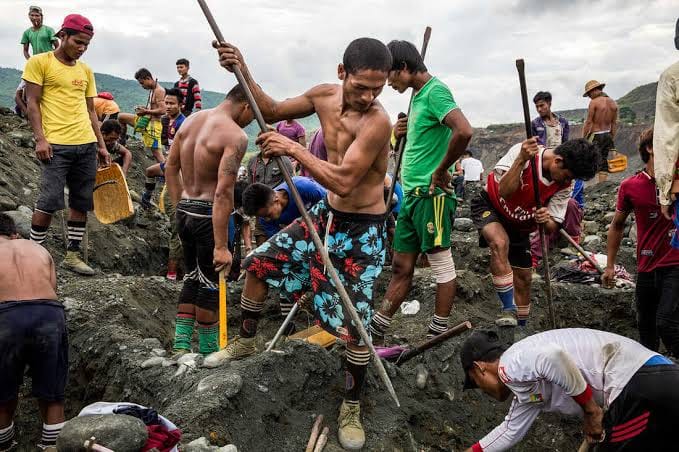Blood and Stones - The Dark Side of Myanmar's Gemstone Industry

Risky Business: The Dangers of Gemstone Mining in Myanmar
Gemstone mining in Myanmar is a risky business, with many mines located in conflict areas. The country's gemstone industry is notorious for its lack of regulation, environmental degradation, and association with armed conflict. The dangers of gemstone mining in Myanmar are multifaceted and far-reaching, affecting not only the miners themselves but also the environment and local communities.
Conflict Areas and Unregulated Mining
Many gemstone mines in Myanmar are located in conflict areas, where armed groups and military forces are present. This creates a high-risk environment for miners, who may be subjected to forced labor, extortion, and violence. The lack of regulation and oversight in these areas means that mining operations are often unmonitored, leading to environmental degradation and human rights abuses.
Environmental Degradation
Gemstone mining in Myanmar has significant environmental impacts, including deforestation, soil erosion, and water pollution. The use of heavy machinery and chemicals in mining operations can damage ecosystems and contaminate water sources, affecting both local communities and wildlife. In addition, the clearing of land for mining can lead to loss of biodiversity and soil degradation.
Human Rights Abuses
The gemstone industry in Myanmar has been linked to various human rights abuses, including forced labor, child labor, and violence against local communities. Miners often work in hazardous conditions, without proper safety equipment or fair compensation. In some cases, local communities have been forcibly displaced to make way for mining operations, leading to loss of livelihoods and cultural heritage.
A Devastating Landslide in Hpakan
The Hpakant township in Kachin state is a prime example of the dangers of gemstone mining in Myanmar. In February 2022, a landslide in the area killed at least 23 people, highlighting the risks faced by miners and local communities. The incident also drew attention to the lack of regulation and oversight in the industry, with many mines operating without proper safety measures or environmental assessments.
Endemic Corruption: The True Cost of Myanmar's Gemstone Wealth
Myanmar's gemstone industry is plagued by endemic corruption, which undermines the sector's potential to contribute to the country's development. Corruption is deeply ingrained in the industry, with mining companies facing extortionate fees at every turn.
Extortionate Fees and Bribes
Mining companies operating in Myanmar are required to pay a range of fees to local authorities, including the military and government officials. These fees vary depending on the location and type of gemstone being mined, with companies often facing demands for bribes to secure permits, licenses, and access to mining areas.
A Culture of Corruption
The culture of corruption in Myanmar's gemstone industry is perpetuated by a lack of transparency and accountability. The opaque nature of the sector makes it difficult to track the flow of money and gems, allowing corrupt officials to exploit the system for personal gain.
The True Cost of Corruption
The true cost of corruption in Myanmar's gemstone industry goes beyond the financial burdens placed on mining companies. It undermines the rule of law, perpetuates human rights abuses, and deprives local communities of the benefits of their natural resources.
Resource and Conflict: The Devastating Impact of Gemstone Mining
Gemstone mining has had a profound impact on local communities in Myanmar, with far-reaching consequences that extend beyond the mining itself.
Displacement and Conflict
Gemstone mining has led to the displacement of countless local communities, as villages are forced to make way for mining operations. Many have been forced to flee their homes due to conflict, leaving behind their livelihoods and heritage. The conflict surrounding gemstone mining has also led to human rights abuses, with reports of forced labor, violence, and intimidation.
Environmental Devastation
The environmental impact of gemstone mining is equally alarming. Deforestation and water pollution are common in mining areas, with the clearance of land for mining leading to the destruction of habitats and ecosystems. The use of chemicals and heavy machinery in the mining process also contaminates nearby water sources, posing a significant threat to both human health and the environment.
The devastating impact of gemstone mining in Myanmar is a stark reminder of the true cost of the gemstone industry. As consumers, it is essential to be aware of the origins of the gemstones we purchase and to support companies that prioritize responsible and sustainable mining practices.
The Deadly Gamble of Jade Mining in Myanmar
Jade mining is a perilous and potentially deadly endeavor in Myanmar, where miners risk life and limb in pursuit of a precious stone. The allure of a quick profit drives many to take enormous risks, often with devastating consequences.
A Hazardous Occupation
Jade mining is particularly hazardous, with many miners risking their lives for a quick profit. The mining process involves excavating tunnels and shafts in unstable terrain, often without proper safety equipment or precautions. This can lead to catastrophic accidents, including tunnel collapses, explosions, and toxic gas exposure.
A Lucrative Industry with Few Benefits for Locals
The jade industry is worth billions of dollars, but the benefits rarely reach local communities. Instead, the profits often line the pockets of corrupt officials, military leaders, and wealthy businessmen. This has led to a cycle of exploitation, where local populations are forced to endure the environmental and social costs of mining without receiving fair compensation or benefits.
Conclusion: The Need for Reform in Myanmar's Gemstone Industry
A Call for Change
The gemstone industry in Myanmar is in need of urgent reform, with greater transparency and regulation required. The current state of the industry is marred by corruption, conflict, and environmental degradation, which has severe consequences for the country and its people.
Consequences of Inaction
Until then, the industry will continue to be plagued by corruption, conflict, and environmental degradation. The lack of transparency and regulation allows for illegal activities to thrive, perpetuating a cycle of violence and exploitation.
A Path Forward
Reform is necessary to ensure that the gemstone industry benefits the people of Myanmar, rather than just a select few. This can be achieved through increased transparency, regulation, and accountability, as well as investment in sustainable mining practices and environmental protection.











Comments ()